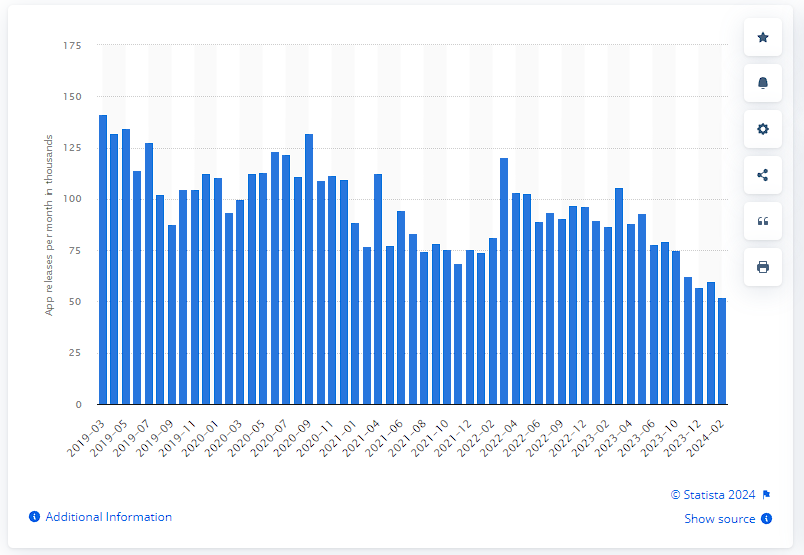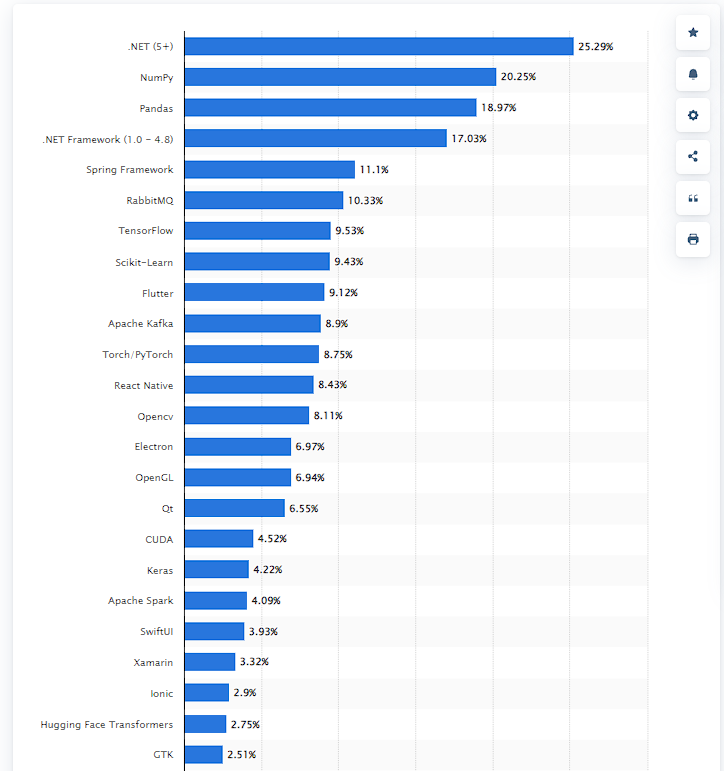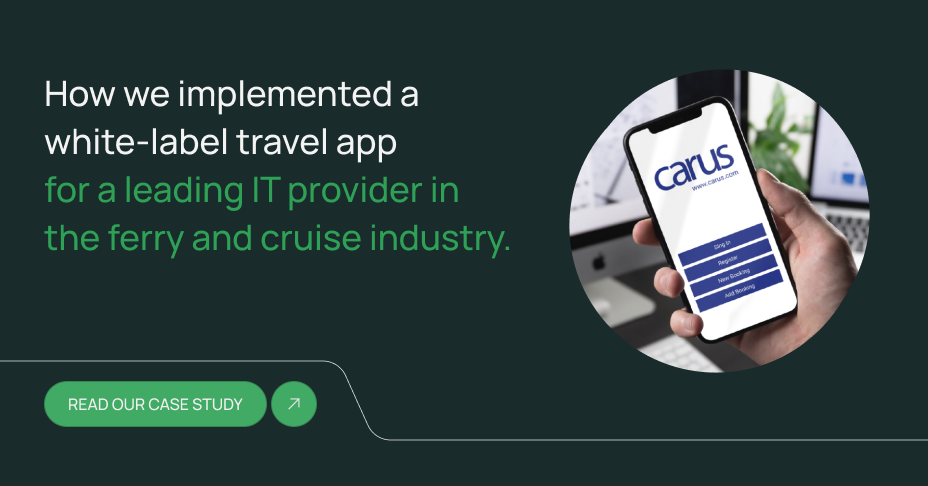
The custom software development market size had reached $28.2 billion in 2022, with a projected CAGR of 21.5% between 2023 and 2032. Simply put, the industry is growing exponentially, with new trends emerging all the time. The world is quickly embracing digital transformation, leading to increased demand for all types of software.
To adapt to these changes, any company or individual with stakes in this field should pay attention to custom software development trends. For example, NFTs and Web 3 technologies were valued at $16 billion in 2021. Companies that managed to embrace this trend in time earned quite a lot.
In this blog, we’ll cover the 10 top trends in custom software development that shape the industry here and now. Our insights are based on the personal experience of Vector Software’s developers and reports from reliable sources like Gartner, Statista, Grand View Research, and many others.
Custom Software Development Statistics for 2024
According to Evans Data Corporation, by the end of this year we can expect to have 28.7 million individuals working in software development. That’s 20% more than in 2020, meaning the market has no shortage of new experts with a fresh view of the industry. Moreover, each month, new software is created and released. For example, February 2024 saw about 52,000 mobile apps released through the Google Play Store—and that’s only mobile software made for Android!

A survey conducted by Statista in 2022–2023 shows that .NET (5+) is the leading framework among developers, with 25.3% of respondents having experience with it. NumPy for Python occupies the second spot, with 20.2% of respondents claiming proficiency in it. You can see the full report below.

A recent report by Gartner predicts that 40% of large organizations will be using Web3, spatial computing, and other related technologies to increase revenue in the near future. Another report from the same company indicates that 40% of enterprise applications will embed conversational AI by 2024. Meanwhile, Google and OpenAI remain the major players in the area.
With basic statistics out of the way, let’s examine the leading trends in custom software development to see what to expect in the future. You’ll probably be quite surprised by some entries in this list.
Top 10 Trends in Custom Software Development
1. Artificial Intelligence and Machine Learning
According to the Forbes Advisor survey, 56% of respondents are using AI to improve business operations. This technology, combined with advanced machine learning, will become a leading trend in 2024–2025. It’s not surprising: we already feel the impact of AI and ML in almost all industries.
Our team has many case studies where AI and ML are the leading technologies in our clients’ projects. For example, traffic recognition systems and vehicle classification systems benefit immensely from the recent machine learning tools.
Here’s why AI and ML are the leading trends for today:
- Automation: Existing AI technologies can absorb up to 70% of workers’ time today, allowing humans to focus on more complex and creative tasks. Additionally, automation reduced the risk of human error in most cases.
- Predictive analytics: 95% of companies use AI-powered predictive analytics to guide their marketing strategies. This helps them forecast trends based on historical data, predict sales, and conduct preventive maintenance.
- Personalization: Marketing, retail, and entertainment industries benefit the most from AI in personalization. Businesses can tailor user experiences and provide unique recommendations based on their customers’ needs.
AI is constantly advancing and becoming more popular all around us. ChatGPT, the most well-known AI model, reached 1 million users during the first five days of its release. This demonstrates that people are interested in this technology, and it’s already becoming an integral part of our lives.
2. Cloud Computing

This trend emerged because of this technology’s impact on business operations and scalability. 39% of companies stated that using the cloud helped them cut costs, reducing the maintenance costs of physical infrastructure and hardware.
Here are the key points in this trend:
- Scalability: Cloud services allow you to easily upscale or downscale your operations, allowing your business to adapt to changing needs. Why buy another server when you can simply switch your price plan?
- Cost-efficiency: You don’t have to buy, upgrade, and maintain physical servers and infrastructure. The pay-as-you-go models help your business save money and delegate the typical maintenance hustle to the provider.
- Data backup: In 2022, 60% of all corporate data was stored on the cloud. Now, this number is even higher, and for a good reason: cloud data is protected from physical vulnerabilities and has multiple backups from the vendor’s side.
The cloud market is projected to grow at a CAGR of 16.5% during 2024–2032, reaching a staggering $2.3 billion in size by the start of next decade.
3. Blockchain Technology
80% of major companies use blockchain in their operations. The technology’s potential to provide secure, transparent, and efficient ways to record and share data makes it a lucrative option for software developers.
Let’s see some key elements of this trend:
- Decentralization: Blockchain works as a decentralized network, distributing data across multiple nodes. This way, there’s no need for a central authority. Additionally, the risks of fraud, data tampering, and downtime are significantly reduced.
- Security: Blockchain’s architecture is extremely secure due to cryptographic hashing and the consensus mechanisms handling any changes to the ledger. Each block is linked to the previous one, making it extremely difficult to alter historical data without leaving a trace.
- Transparency: All blockchain transactions are visible to all of the system’s participants and cannot be changed after confirmation. This ensures all transactions are verifiable and traceable.
Vector Software’s experts state that most solutions will be blockchain-based by the end of the decade, eliminating the extensive bureaucracy of today.
4. Datafication

The global datafication market size was estimated at $310.19 billion in 2022 and is projected to reach $1,013.57 billion by 2032, growing at a CAGR of 12.57%. This industry relies on the transformation of everyday actions and processes into quantifiable data, a trend that is impacting many sectors by unlocking new insights.
Here’s why it’s important:
- Improved decision-making: Businesses can collect and analyze vast amounts of data from social media, websites, devices, and many other physical and digital sources.
- Improved personalization: Marketing, healthcare, retail, and other human-centered industries can use datafication to make their customer services more personalized. Businesses and organizations will know more about their clients, helping them solve their issues more efficiently.
- Optimization: Access to more data helps companies streamline operations by identifying inefficiencies. In manufacturing, analyzing data from sensors can predict maintenance needs, prevent downtime, and enhance productivity.
Vector Software’s team already uses this approach when working with IoT and AI-based solutions for our customers. Additional information means a broader strategic view, and that’s what we value.
5. Internet of Things
The number of IoT-connected devices is expected to reach 29,42 billion by 2030. Creating programs for these devices is one of the relatively new trends in custom software app development, but it’s already making shockwaves across the development industry. IoT devices are used in vehicles, buildings, home appliances, and many other technologies we use daily. This trend is also connected with datafication, creating new sources of data everywhere.
IoT devices are a trend due to:
- Automation and efficiency: Such tools can cover routine tasks across various industries and do it better than any human could manually.
- Improved user experience: You can use various sensors to create use scenarios and make peoples’ lives better with predictability and convenience.
- Technological growth: The fast adoption of AI and ML also benefits IoT solutions, making them smarter and more responsive.
That’s why IoT is the latest trend in custom software development for all kinds of industries. Its efficiency and cost-effectiveness are what bring about the technological changes we’re seeing right now. For example, IoT devices are very popular in the custom software for the maritime industry due to their multifunctional use.
6. Low-Code Development
The low-code development platform market is projected to reach $32 billion by the end of 2024. It’s hardly surprising considering that 33% of respondents stated their companies use low-code for data visualization and modeling.
Here’s why low-code is one of the biggest custom software development trends:
- Faster development: The drag-and-drop interfaces, pre-built templates, and automated workflows allow engineers to create applications much faster than with manual coding.
- Cost-efficiency: Low-code platforms require less time, effort, and knowledge to operate. This leads to reduced expenses, allowing you to create more products for the same cost.
- Easy integration: Low-code platforms usually provide built-in integrations with third-party services, databases, APIs, payment solutions, and many others.
Be advised that while you can easily create basic software solutions by using low-code, you’ll likely still need professional engineers to bring your ideas to life because of the method’s limitations.
7. Internet of Behavior
The Internet of Behavior is one of the leading trends in custom software development, merging technology, data analysis, and IoT devices to enhance user experiences and offer personalized services.
Here are some factors that drive this trend:
- IoT devices: They generate terabytes of data and help companies get insights into user behaviors, preferences, and routines.
- Data integration: IoB integrates data collected from various sources, including online activities, GPS tracking, and IoT devices, creating expansive profiles of user behavior.
- Personalization: IoB enables hyper-personalization of marketing and customer services, ensuring users get unique experiences that drive conversions.
- Better product development: Insights derived from IoB can inform product development and innovation, allowing developers to better understand how users interact with products.
The IoB trend is a shift toward data-driven decision-making and a deeper integration of digital technologies in our daily lives. Considering that data is of the highest value for all companies, it makes much sense.
8. Microservices Architecture
Common use of microservices is another one of the custom software development technology trends that become more pronounced recently. This approach allows engineers to create more efficient and well-structured applications, speed up development, and improve software performance.
The key features behind the popularity of microservices are:
- Scalability: Microservices allow applications to be broken down into smaller components that can be scaled independently. It’s a valuable tool for the modern cloud-based processes, as they require companies to dynamically allocate resources across services.
- Flexibility: Various microservices utilize a broad range of technologies, allowing developers to choose the best tech stack for each option. This means you can experiment with individual components without the risk of impacting the whole system.
- Speed: Microservices are developed and deployed independently. Updates and maintenance are conducted individually without redeploying the entire software, leading to faster iterations.
Microservices are an excellent way to make your software highly scalable, agile, and reliable.
9. Web 3.0
The Web 3.0 market size was valued at $2.25 billion in 2023 and is projected to grow at a CAGR of 49.3% from 2024 to 2030. It’s a trend driven by foundational changes and technological advancements like blockchain, NFTs, and DApps.
Here’s why Web 3.0 made it to the custom software development market trends:
- Decentralization: Decentralized data management means data is distributed across many nodes through blockchain, making the whole system more secure.
- AI and ML: These technologies are a big part of the Web 3.0, processing vast amounts of data for personalized and effective services.
- Semantic web: All data is interconnected in a meaningful way that can be easily understood and applied by machines, ensuring a focus on the meaning of words rather than keywords.
Considering that nearly 73 million gamers use Web3-based games, we believe the industry will grow further. It’s important to be ready for the tech’s challenges and be prepared to quickly adapt to changing conditions.
10. DevSecOps
36% of respondents indicated they used DevSecOps in their work. This trend concerns the integration of modern security practices throughout the entirety of the software development lifecycle, expanding DevOps philosophy to include security as its core component.
Here’s why DevSecOps is gaining traction:
- Security: DevSecOps shifts security “left”, meaning it integrates security considerations early and throughout the development process.
- Speed: Integrating security into the CI/CD pipeline allows organizations to automate safety checks and ensure they are both quick and reliable.
- Compliance: Integrating security into the development process helps organizations comply with industry regulations.
- Automation: DevSecOps leverages tools that automate security testing, reducing manual workload while maximizing safety.
The biggest challenge with DevSecOps is the difficulty in finding skilled professionals. If you struggle with this issue, we at Vector Software have over 160+ engineers, including DevSecOps specialists, ready to work on your project.
Key Reasons Why to Choose Custom Software Development for Your Business
Using custom software brings multiple benefits to your company and is much more efficient than using out-of-the-box applications:
- Flexibility. You get a solution tailored specifically for your business, getting all the features your processes require. This way, you can cut off unnecessary components like useless buttons and sections.
- Reliability. Getting your own custom solution ensures everything works as intended for your business to operate non-stop.
- Cost-efficiency. Average companies spend up to $3,500 annually per employee on software tools and licenses. Creating a custom solution allows you to spend money on your own product, reducing expenses by removing licensing and price plans.
- Up-to-date. Partnering with a custom software development company allows you to ensure your application is always working on the latest technologies and can be updated to keep up with the emerging tech.
Why Vector Software is Your Eligible Partner for Software Development
Vector Software is a reliable custom software development company with extensive experience working with various industries. With more than 18 years on the market and 160+ professional engineers, we have all the expertise needed to bring any idea to life. From complex IoT solutions to high-level Web 3.0 development services, our team will ensure you’ll get a functional, sophisticated, and convenient application.
Check out our case studies:
- VISSIM: a vessel traffic management system, monitoring up to 200,000 vessels in real time;
- Øresund Bridge: a real-time tollgate traffic management system with AI vehicle detection and license plate recognition;
- Carus Vehicle Classification: an automatic vehicle classification system that works at port check-ins.

Book a call now with our experts to start developing your software with real professionals.
Conclusion
As clearly seen in the modern trends in custom software development, the industry is dead-set for growth and innovation. Each new technology also drives all connected industries, leading to nearly guaranteed new advancements. Both historic and projected market growth proves that.
If your business wants to stay on top of the competition, you’ll have to partner with a trusted company like Vector Software to stay on top of these new technologies. Our experts work with AI, ML, IoT, Web 3.0, and other trending solutions to help you get high-quality software that supports your operations. Let’s team up today!
FAQ
How can businesses incorporate new trends into their development cycles?
The easiest way to do so is to partner with a software development company to get custom solutions for your operations. Working with a team of engineers to build custom software ensures that your company gets a modern application with all the cutting-edge tech you may need.
How will top custom software development trends help businesses grow in 2024–2025?
By utilizing these trends, businesses can improve their operations, reduce development time, and optimize costs. Companies can get more data insights, automate their workflows, and improve decision-making by embracing emerging technologies and approaches like Blockchain, AI, Cloud, and so on.
What is the biggest latest trend in custom software development?
The Internet of Behavior (IoB) is currently the biggest trend in custom software development. It helps companies use data from all kinds of IoT devices to form patterns and routines, better understand their customers, and provide personalized services.
Ready to streamline your software solutions?
Let’s dive in together. Get expert consulting from our seasoned engineers.
 by
by 




